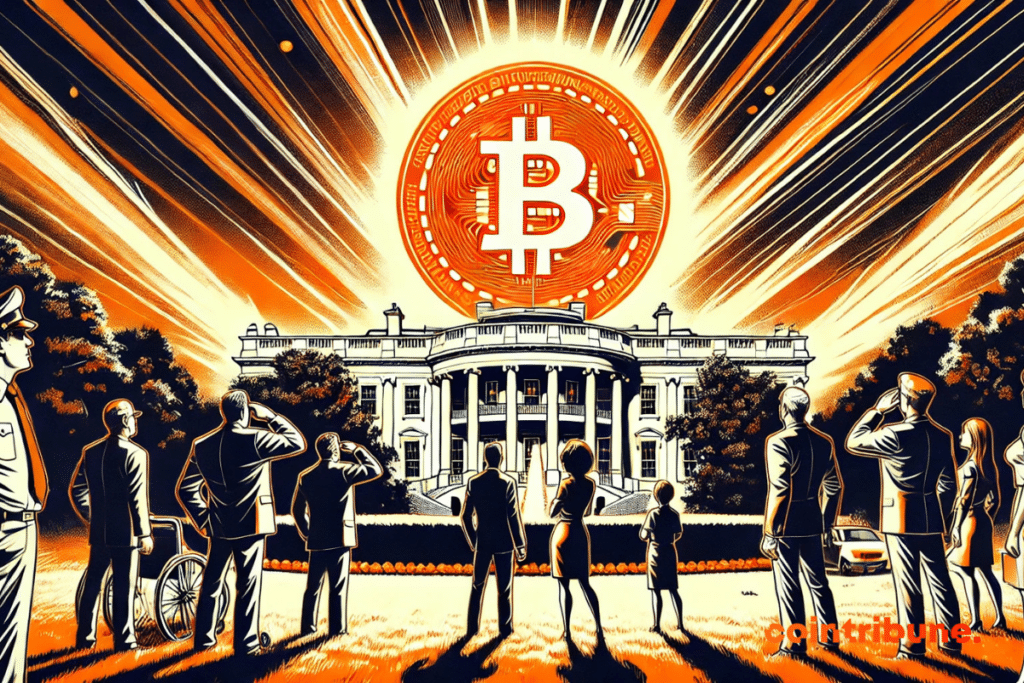Bitcoin’s Drop Has (Almost) Nothing To Do With The Trade War, According To Some Indicators
While the trade war reignited by Washington captures attention, bitcoin is stagnating around $85,000. Some see a cause-and-effect link. However, this quick reading overlooks the essential: it is not geopolitics that is hindering the market, but the absence of concrete catalysts and a silent redistribution of flows towards safer assets. To understand this inertia, one must go beyond this analysis and follow the true signals of the market.

The illusion of a direct link between trade war and BTC weakness
On January 21, 2025, the announcement by the Trump administration of a 10% tariff on Chinese imports marked a new escalation in the trade war initiated by the United States. Quickly, some analysts established a direct link between this geopolitical tension and the stagnation of bitcoin.
However, the data does not validate this correlation. Bitcoin did not manage to stay above $100,000 in the three months prior, well before the new tariff measures came into effect.
Some market players have claimed that the $5.25 billion worth of bitcoin purchases by Strategy since February are the main reason why BTC has remained above the $80,000 support.
Moreover, during the same timeframe, the S&P 500 reached a historical record on February 19, thirty days after the official start of the customs conflict, illustrating a market dynamic that did not follow the same tempo as that of BTC.
The other element that contradicts this simplistic reading is the behavior of institutional investors. Between January 21 and February 18, during the rise of trade tensions, Bitcoin spot ETFs recorded $2.75 billion in net inflows.
This indicates an increased, even growing, demand from institutional players despite the geopolitical context. Additionally, several key indicators show that the price of BTC is evolving independently of the trade war:
- Bitcoin was already capped below $100,000 well before the start of the trade conflict.
- The S&P 500 reached a historical high, evidence of confidence in traditional markets at the same time.
- Flows into Bitcoin ETFs remained strong, confirming sustained institutional appetite.
- No clear break in the BTC trend was observed immediately after the tariff announcements.
- Comparative analysis with other assets, such as gold or bonds, shows that BTC reactions operate within their own logic, and are not strictly correlated to geopolitics.
In summary, the data contradict the idea of a mechanical link between the trade war and the retreat of BTC. International tensions serve as a backdrop, but are neither the trigger nor the main engine behind recent developments in the crypto market.
Unrealistic expectations, controlled inflation, and risk aversion: the real top trio
If the role of trade tensions seems overvalued, another series of factors more precisely explains the current weakness of bitcoin.
First, the highly anticipated announcement of a “national strategic reserve of bitcoin” by President Trump greatly disappointed. The initial promise, mentioned at the Bitcoin Conference in July 2024, had fueled hopes for massive institutional support.
However, investor frustration peaked when the executive order was finally published on March 6, revealing content far less ambitious than expected. Thus, this disillusionment weighed heavily on investor morale.
Meanwhile, macroeconomic data indicates a much less favorable environment for a BTC rally. Inflation remains contained: the PCE index rose 2.5% year-on-year in the U.S. in February, and the eurozone CPI index reached 2.2% in March.
In other words, one of bitcoin’s historical drivers (the fear of runaway inflation) is fading. Furthermore, the U.S. job market shows signs of weakness, with job openings near their lowest level in four years.
Two-year Treasury yields fell to 3.88%, a sign of a clear return to risk aversion. Such capital is directed towards assets perceived as safer, temporarily sidelining cryptos.
This context may indicate a lasting repositioning of investors. In the short term, bitcoin may continue to evolve in a consolidation zone, unless a major external shock occurs. However, in the medium term, if inflation were to rise again or if more assertive political support for BTC materialized, a new bullish cycle could ensue. In the meantime, operators will have to deal with a more tempered macroeconomic environment and a crypto market that has returned to a form of maturity, where simplistic narratives are no longer enough to shift the lines.
Maximize your Cointribune experience with our "Read to Earn" program! For every article you read, earn points and access exclusive rewards. Sign up now and start earning benefits.
Diplômé de Sciences Po Toulouse et titulaire d'une certification consultant blockchain délivrée par Alyra, j'ai rejoint l'aventure Cointribune en 2019. Convaincu du potentiel de la blockchain pour transformer de nombreux secteurs de l'économie, j'ai pris l'engagement de sensibiliser et d'informer le grand public sur cet écosystème en constante évolution. Mon objectif est de permettre à chacun de mieux comprendre la blockchain et de saisir les opportunités qu'elle offre. Je m'efforce chaque jour de fournir une analyse objective de l'actualité, de décrypter les tendances du marché, de relayer les dernières innovations technologiques et de mettre en perspective les enjeux économiques et sociétaux de cette révolution en marche.
The views, thoughts, and opinions expressed in this article belong solely to the author, and should not be taken as investment advice. Do your own research before taking any investment decisions.